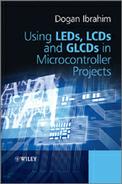Chapter 15
Using the Visual TFT Software in Graphics Projects
Visual TFT is a standalone software package used for the development of TFT based colour graphical user interfaces in embedded devices. With the help of the software, users can create screens and place drag-and-drop components on these screens, which can be used for building complex graphical applications. The Visual TFT software generates code compatible with the mikroC Pro for PIC and similar compilers developed by mikroElektronika.
Current version (2.01) of Visual TFT supports the following features:
- 15 graphical user interface components with full colour;
- full colour multiple screens;
- automatic code generation for compilers;
- multiple font support, such as regular, bold, italic, underline and strikeout;
- support for external memory;
- ‘On Press/release’ procedures when objects are clicked (event driven design);
- changing properties of multiple objects at the same time;
- zoom in/out option for each screen generated;
- show/hide grid options;
- print and print preview of current screen.
The Visual TFT software must be installed before it can be used. Download the software from the mikroElektronika Web site: http://www.visualtft.com. Start up the software by double clicking on the appropriate icon. The Visual TFT IDE will appear on the screen and you are now ready to use the software (you may need to have a licence or a dongle to use the software to full capacity).
Both the Visual GLCD and Visual TFT software packages have similar user interfaces. The steps to create a graphics application using the Visual TFT are similar to those used while creating Visual GLCD applications:
Several examples are given in this chapter, to show how the Visual TFT software can be used in graphical projects. The first project gives all the steps in detail, while the other projects simply describe the important points in each project.
The projects described in this chapter are based on the graphics development board called ‘MikroMMB board for PIC18FJ’, developed by mikroElektronika (http://www.mikroe.com). This is a 8 × 6 cm small graphics development board (see Chapter 4), with a built-in 320 × 240 pixel colour TFT display on one side, and a PCB with components on the other side. The board includes everything necessary for creating powerful TFT based graphics applications. The key features of the board are:
- TFT 320 × 240 pixel display with resistive touch panel;
- Display capable of showing data in 262 000 different colours;
- PIC18F87J50 microcontroller;
- 8 MHz Crystal oscillator;
- microSD card slot;
- Stereo MP3 coder/decoder (VS1053);
- 3.5 mm headphone connector;
- USB mini connector;
- 8 Mbit serial flash memory (M25P80);
- Reset button;
- three axis Accelerometer (ADXL345);
- I/O connection pads.
The board is powered from the USB port and on-board voltage regulators ensure the appropriate voltage levels to each part of the board. A power LED indicates the presence of a power supply. The board can also be powered using a Li-Polymer battery, via an on-board battery connector. The microcontroller on the board can be programmed using the Bootloader software loaded to the microcontroller, or external programmers can be used (e.g. mikroProg or ICD2/3).
In this chapter, we will be using the Bootloader software to load our programs to the microcontroller on the MikroMMB board. Load and install the PC end of the Bootloader software from the Web site:
http://www.mikroe.com/eng/products/view/585/mikromedia-for-pic18fj/
